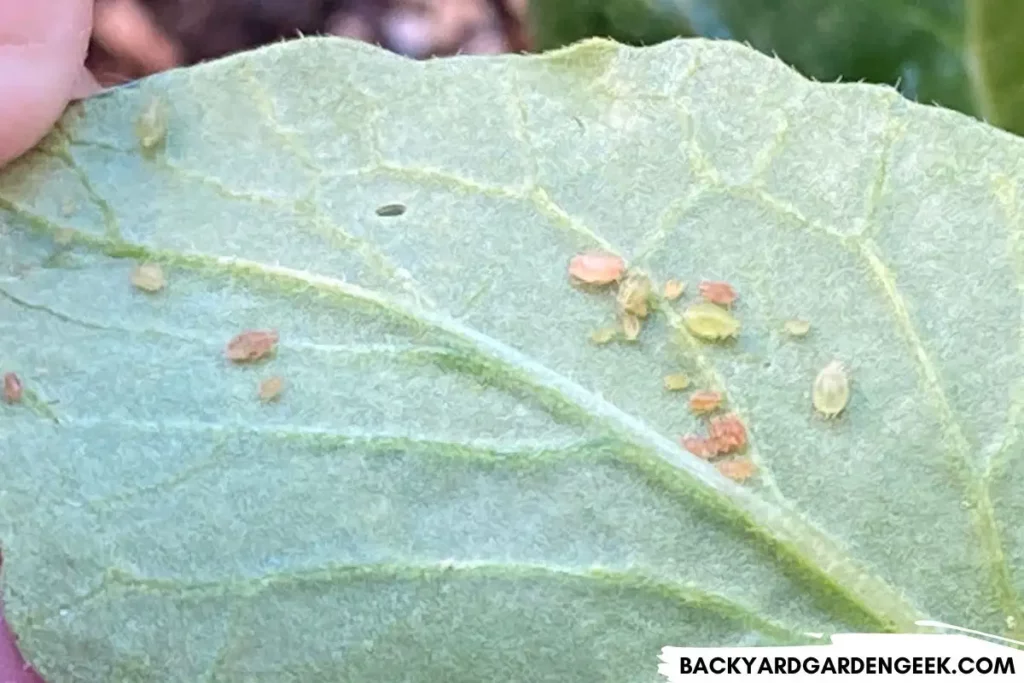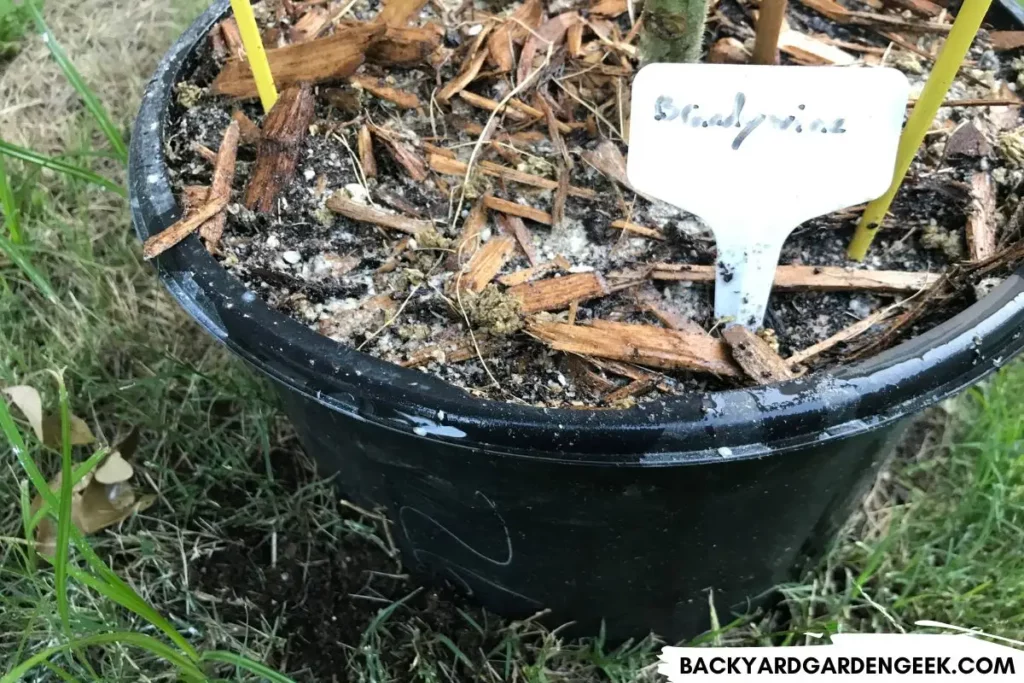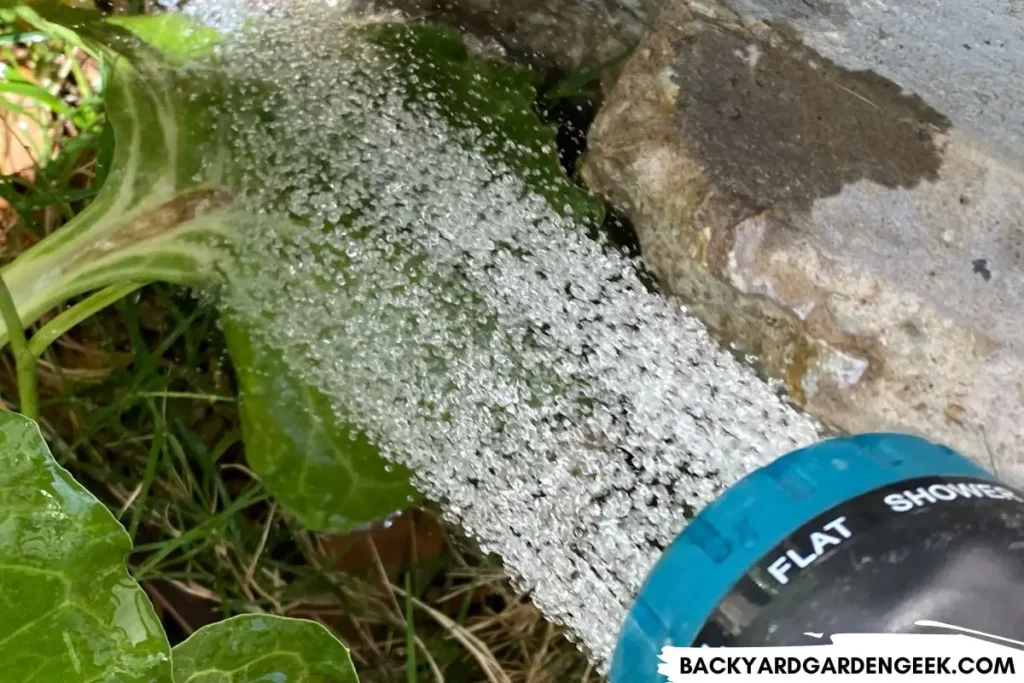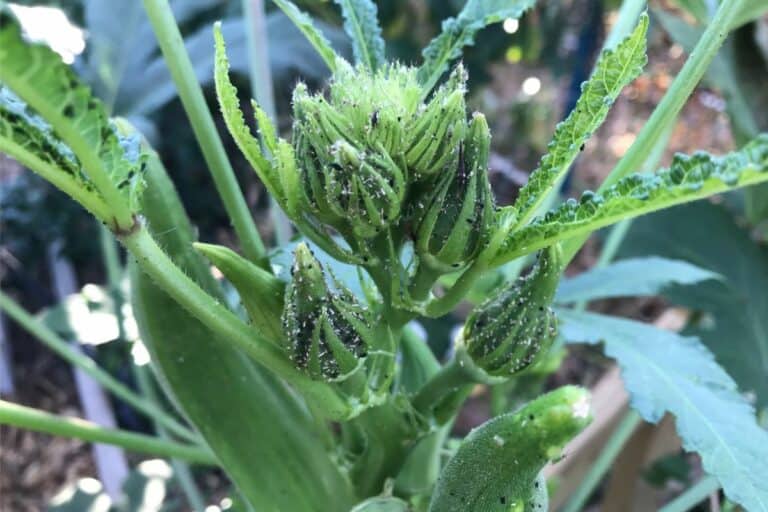9 Simple Ways to Get Rid of Ants on Tomato Plants
Have you ever seen ants running up and down your tomato plants? If this has happened to you, you might be wondering: Why are ants on my tomatoes? And how do I get rid of them?
The best ways to get rid of ants on tomato plants are to use homemade barriers such as bands of diatomaceous earth or a ring of sticky petroleum jelly around the base of the plants to keep ants from climbing. Borax, orange oil, and soapy water can also be used to kill off ants and their colonies.
In this article, I’ll go into more detail about these and other ways to get rid of ants on your tomato plants. Here’s what I’ll cover:
- the two main reasons why ants will crawl all over your tomato plants.
- various effective, natural ways to get rid of ants on your tomato plants.
- important information about the role ants play in the pollination process.
As long as you aren’t dealing with leafcutter or fire ants, ants generally aren’t all that destructive in your garden. They’re an important part of your property’s natural ecosystem.
But they can be signs of other things going on–and they can also be a nuisance if you’ve got the stinging sort among your plants–so it’s best to understand why they’re there and what you can do about them.
I’ll be sharing some product recommendations below–which will allow me to make a small commission at no extra cost to you–but I’m very cautious about the products I recommend to my readers (see my product disclosure page for more details).
I’ll explain more below, but when it comes to ants, I’ve had success with these products over the years:
- Harris Diatomaceous Earth: This works really well, but you’ve got to be careful. Read below to find out why.
- Safer Brand Insect Killing Soap: I’m careful with soaps like this, but if used correctly, it’s a great solution.
- Nature’s Wisdom Horticultural Molasses: You can use horticultural molasses for all kinds of things, including keeping bad bugs away from your plants.
- Green Gobbler Orange Oil: Lots of uses for this product, but it’s great as a bug repellent.

Why Are Ants on My Tomato Plants?
The two main reasons ants are on your tomato plants are:
- You have an infestation of aphids.
- The extrafloral nectaries on your tomato plants are active.
Let’s take each one and explore what’s going on, beginning with aphids.
A heavy presence of ants on your tomato plants most likely means you have an infestation of aphids. It’s the honeydew they’re excreting that’s attracting the ants.
That’s because ants and aphids have a mutually beneficial symbiotic relationship. Called mutualism, it’s when both species benefit from their association.
Here’s what happens:
Ants feed on the sugary excretion called honeydew produced by aphids as a waste product of their feeding. In return, ants protect the aphids from predators and parasites and even transport them from one plant to another.
In this way, ants act shepher the aphids, tending and protecting them to ensure a steady supply of honeydew. Therefore, it’s not the ants causing the problem; it’s the aphids.

If you’d like to learn more about this before reading further, check out these articles:
- Do Aphids Attract Ants?
- Do Ants Eat or Kill Aphids? 6 Environmental Factors
- Do Ants Make Aphids Worse? 7 Behaviors to Understand
- Why Do Ants Protect Aphids? 7 Things You Should Know
Simply put, the process of extracting sap from your tomato plants can cause damage to them.
The puncture wounds made by the aphid’s mouthparts can provide entry points for plant pathogens, and the loss of sap can cause wilting and yellowing of the leaves. Additionally, the honeydew they excrete can lead to the growth of sooty mold on the leaves, further harming the plant.
The second reason why you might be seeing ants on your plants has to do with the extrafloral nectaries on your tomato plants.
Tomato plants produce tantalizing nectar in extrafloral nectaries—knob-shaped small glands on the plant’s leaves and stems. These nectaries produce a sugary substance that attracts ants, which feed on the nectar.
Like ants and aphids, ants and tomato plants also have a mutualistic relationship.
In return for the nectar, ants will aggressively defend your tomato plants against other herbivorous insects, like aphids, whiteflies, and caterpillars, which can cause significant damage to the plant.
In some ways, this is a bit ironic. Ants will protect aphids, even if they’re damaging your tomato plants. But if your tomato plants are excreting their own sugary substances, ants will defend the plants against aphids and other bugs that might end up harming them.
How cool and weird is that!
9 Ways to Get Rid of Ants on Your Tomato Plants
Now that we’ve covered the reasons why you might be seeing ants on your tomato plants, let’s look at the ways you might best get rid of them.
Here’s a quick glimpse of the various ways you can do so, but I’ll explore each of these methods in more detail below:
| Ant Barriers | There’s several options out there, but DE is my favorite. |
| Borax Bait Traps | I’m new to using borax, but I’ve had some promising results. |
| Citrus Peels | They work, but it’s a very temporary solution. |
| Companion Planting | I try to practice companion planting as often as possible, especially around the edges of my raised beds. |
| Insecticidal Soap | This’ll kill both ants and aphids on contact, but it won’t destroy an ant mound. |
| Mound Drench | I’ve used Dirt Doctor’s recipe before. It works. Check out the details below. |
| Orange Oil | This is an amazing product for getting rid of ants in the garden. |
| Vinegar & Water | Vinegar and water will work, mostly through disorienting the ants. |
| Water Blasts | This only works on very small aphid infestations, but it doesn’t hurt to try! |
The best way to get rid of ants on tomato plants will depend on the severity of the infestation, so here’s a detailed summary of 9 natural methods you can try out in your garden next time you see ants on your plants:
1. Ant Barriers
Creating an ant barrier is a simple and effective way to prevent ants from climbing the stem of tomato plants and tending to their aphid buddies.
Here are a few ways to create ant barriers:
- Copper tape: The copper creates a barrier that ants won’t cross when applied to the stem of your tomato plants.
- Diatomaceous Earth: This natural powder is abrasive to ants and, when sprinkled around the base of your tomato plants, will deter them. I like DE treatments, but you need to be careful because it can kill beneficial bugs as well.
- Petroleum Jelly: This can be applied to the base of the tomato plant to create a barrier that ants don’t cross.
- Tanglefoot: This is a sticky material that can be applied to the base of the tomato plant to keep ants from climbing the stem. The ants will get stuck in the sticky material and be unable to reach the aphids.
When using any of the above methods, reapply the barrier after it rains or when it becomes less effective.

I like DE, but once it gets wet, it’s no longer very useful. Wait for the soil to dry out, then reapply it again around the base of your plants.
2. Borax Bait Traps
A great way to get rid of ants on tomato plants is to use ant bait traps. Bait traps are a highly effective method of controlling ants because they will attract ants and, once ingested by them, will transfer the poison, killing the queen and the colony.
Mix .5 cups (118 ml) with 1.5 tablespoons (22 ml) of food-grade borax with 1.5 cups (360 ml) of warm water and place it in a plastic bottle.
The sugar will attract ants, and the borax will kill them. Poke holes in the bottle and lay the borax traps near your tomatoes. You can also soak cotton balls and lay them around your plants as well.
Ant control is often a process that requires a combination of different methods and using bait traps alone may not be sufficient for heavy infestations.
Try some of the methods below in conjunction with bait traps to achieve best results.
3. Citrus Peels
Did you know that you can place citrus peels around the base of the tomato plants? The strong scent of citrus will repel the ants.
The best peels are those from grapefruits, lemons, and oranges. You can use limes too.
Just know that this is a temporary solution. Citrus peels aren’t going to keep the ants away, but they’ll sometimes disrupt their pheromone trails.
4. Companion Planting
Companion planting is a gardening technique where certain plants are grown near each other to provide mutual benefits.
Companion plants beneficial to tomatoes include:
- Basil has a strong scent that’s unappealing to aphids and ants. Garlic has a strong odor that can repel aphids and ants.
- Catnip repels aphids and ants while attracting beneficial insects like ladybugs and parasitic wasps.Chives have a strong odor that can repel aphids and ants.
- Dill is a natural repellent for aphids.
- Marigold is known to repel aphids and secrete a chemical that can inhibit the growth of nematodes (microscopic worms that can damage the roots of tomato plants).
- Nasturtiums repel aphids while attracting beneficial insects like ladybugs and lacewings.

Just know that companion planting is not a guaranteed solution. I recommend using it in combination with other methods.
5. Insecticidal Soap
The best way to eliminate aphids on tomato plants is to use insecticidal soap. You can purchase one at your local garden center or DIY from ingredients you already have at home.
Mix 1-5 tablespoons (15-74 ml) of liquid soap with a gallon of water in a spray bottle. Apply directly to the leaves and stems of the tomato plant, making sure to cover both sides of the leaves. Reapply frequently to eliminate ants.
I mention 1-5 tablespoons because there’s lots of flexibility with insecticidal soap. If you’re got a bad infestation of aphids and ants, go with the stronger solution. For lighter infestations, you can probably get away with 1-2 tablespoons per gallon.
Most importantly, Insecticidal soap must come in contact with the aphids. I recommend spraying your plants later in the day so that you don’t accidentally spray any beneficial bugs as well.
6. Ant Mound Drench
A few years back, I followed the advice of the Dirt Doctor and tried out his mound drench recipe.
Here’s the recipe:
- 1 part compost tea
- 1 part molasses
- 1 part orange oil
Mix the ingredients together and pour them slowly over any mound you find.
Unlike boiling water, which will kill ants but damage any plants that are nearby, this mound drench won’t hurt your plants, so you can apply it to ant mounds that you find in your garden beds.
Here’s a YouTube video if you’d like to learn more about this method:
7. Neem Oil
I’ve written quite a few articles about neem oil since it’s one of my all-time favorite pest management methods.
Neem oil is derived from neem trees (Azadirachta indica), which are found in Africa and all across Southeast Asia.
Cold-pressed neem oil is one of nature’s best insecticides. When ingested by bugs, it disrupts their biological systems, causing all kinds of digestive, hormonal, and reproductive problems.
Neem oil disorients ants. It’ll slow them down, disrupt their foraging patterns, and interrupt their feeding habits. You can also make a neem oil soil drench and pour it directly on their mounds.
My recipe is simple:
- 1 gallon of water (3.8 liters)
- 2 tablespoons of neem oil (30 ml)
- 1 tablespoon of Dr. Bronner’s castile liquid soap (15 ml)
If you’d like to learn more about the many ways I use neem oil in my garden, take a peek at these articles:
- 9 Reasons Your Neem Oil Might Not Be Working
- Can You Use Too Much Neem Oil on Plants?
- Don’t Use Neem Oil on These Garden Plants
- How Can I Make Neem Oil More Effective? My 10-Step Process
- How Long Does It Take for Neem Oil to Kill Bugs?
8. Orange Oil
One of the primary components of Dirt Doctor’s mound drench recipe, orange oil is a great way to deter ants.
The nice thing about orange oil is that you can purchase orange oil sprays online or at local garden centers, then spray directly on ants wherever you see them.
But the best use of orange oil is as a mound drench.
If you want to save money (since the Dirt Doctor’s recipe is a bit pricey), you can take 1-gallon of water and add 1-2 ounces of orange oil to it as well as 2-3 ounces of castile liquid soap.
I prefer Dr. Bronner’s Peppermint Castile Soap. It’s a great, natural liquid soap that works well in a variety of pest management sprays, including insecticidal soap.
9. Vinegar and Water
Mix one part distilled white vinegar with four parts water. Fill a bottle and spray it on or near the ants to erase their pheromone trails.
This is a short-term solution since the ants won’t disappear, so you’ll want to try this method alongside other methods listed above to get more lasting results.
10. Water Blast
Use a strong jet of water to blast the ants and aphids off your plants. This method is best for small infestations, so if you’ve got a larger one, don’t waste your time with this.
You need to spray the plants with enough force to knock the bugs off but not so much force that you damage the plants.
Just remember, this is only helpful for those times when you’ve noticed a few bugs on your plants. If the infestation has already progressed, water isn’t going to do much to aphids.

In addition to these 9 methods, there are also important cultural controls that you can be mindful of. Cultural controls refer to garden management practices used to maintain healthy plants.
Here are a few best practices to keep your tomato plants healthy while reducing the risk of infestation by ants and aphids:
- Adequate Water: Tomatoes require consistent moisture in the soil to grow healthy and produce a bountiful harvest. Watering your plants regularly, especially during dry spells, will help to keep them healthy and less susceptible to infestation.
- Adequate Sunlight: Tomatoes need at least 6-8 hours of direct sunlight daily. Getting sufficient sunlight will help to keep your tomato plants healthy and reduce the risk of infestation.
- Proper Fertilization: Tomatoes require specific nutrients to grow healthy and produce a plentiful harvest. Applying the right fertilizer at the appropriate time will help to keep your plants healthy and reduce the risk of infestation.
- Proper Pruning: Tomato plants benefit from pruning and shaping. Trimming the lower leaves and branches that touch the ground and removing diseased or damaged leaves will help to improve air circulation and reduce the risk of disease and pests.
- Crop Rotation: Rotating where you plant your tomatoes will help reduce the build-up of pests and diseases in the soil, which can lead to less infestation of pests.
- Cleanliness: Keeping the area around your tomato plants free of debris and removing any fallen leaves or fruit can help to reduce the risk of pests and diseases.
Properly maintaining your tomato plants will create an environment that is less conducive to pest infestations.
Do Ants Eat Tomatoes?
If you see ants in your plants, you might be wondering if they’re going to eat your tomatoes, so here’s the good news:
Ants do not typically eat tomatoes since they don’t provide a desirable, significant nutrition. Most likely, they’re attracted to the sugary honeydew excretions produced by aphids hiding somewhere among the foliage.
While ants will indeed crawl on your tomato plants, they’re not going to directly damage the plant or its fruit. However, if you notice many ants on your tomato plants, look underneath the ants with a magnifying glass for their little aphid buddies.

Will Ants Harm My Tomato Plants?
Ants are typically more helpful than harmful when it comes to your garden.
On the helpful side, ants play an essential role in your garden’s ecosystem. They’re scavengers, collecting dead insects and rotting leaves and turning them into fertilizer for your soil.
Much like earthworms, they’ll till through your soil, which will increase its overall health. And they’ll also protect your garden from some pests, including (somewhat ironically) various aphid species, when they’re not already protecting them.
As for harmful, with the exception of leafcutter and red fire ants, ants don’t feed on tomato plants, so tunneling is the only thing to keep an eye on. If you see lot of ants burrowing through the soil, you’ll want to take action since tomato plants that aren’t well established can be damaged by too much soil disturbance.
One final thing to know: Ants play virtually no role in tomato plant pollination.
Tomatoes are self-pollinating, meaning they have flowers that contain both the male (stamen) and female (pistil) parts, so insects aren’t necessary for tomato pollination. All you need is a nice breeze every now and then!
Want to Learn More?
If you’re wanting to learn more about ways to control the pests in your garden, here’s a selection of articles that touch on some of the annoying bugs I’ve had to deal with over the years:






